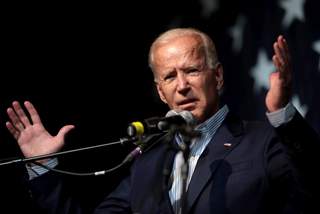
© Wikimedia/Gage Skidmore/Flickr
Workers at the Center: Trade Policy under Joe Biden
Transatlantic trade policy has experienced ups and downs and, above all, some extreme twists and turns in recent years. While two major free trade agreements were still being pushed forward under U.S. President Obama and Vice President Joe Biden – the Transatlantic Trade and Investment Partnership (TTIP) with the European Union (EU) and the Trans-Pacific Partnership (TPP) with a number of Pacific Rim countries –, there was an about-face after Donald Trump took office. The TTIP negotiations, which had already stalled earlier, were completely abandoned. Trump also withdrew his country from the TPP.
According to the motto “America First,” Donald Trump understood international trade as a zero-sum game. For him, a negative trade balance meant that the respective trading partners did not respect the applicable rules of the trading system. High on the agenda was China, but the president was equally critical of the trade policies of close partners such as the EU and Japan. The Trump administration also placed national security interests at the forefront of its trade policy. It used the argument of national security to justify tariffs on steel and aluminum, for example, and threatened tariffs on cars and mobile cranes. The Trump administration conducted free trade negotiations in particular to improve existing agreements, as in the case of NAFTA (now USMCA) or the agreement with South Korea. In addition, it started new negotiations in a few cases, which were not concluded: with the United Kingdom and Kenya.
Joe Biden's Trade Policy Priorities and the “2023 Trade Policy Agenda”
Meanwhile, the Biden administration's own emphases have become clear - particularly in the following fields:
- “Worker-centered trade policy”: Workers are at the center of the Biden administration’s trade policy. This is reaffirmed once again in the 2023 trade policy agenda of the Office of the U.S. Trade Representative (USTR), which was published at the beginning of March. Overall, this agenda builds on the documents from 2021 and 2022 and does not contain any surprising new priorities. For example, according to the "2023 Trade Policy Agenda," trade should serve in particular to expand the middle class, reduce inequality, combat the climate crisis and establish a level playing field. The U.S. administration wants to advocate for workers' rights, for example in its relationship with Mexico through the USMCA, but also in forums such as the G7 and through legislation such as the Uyghur Forced Labor Prevention Act. Promoting U.S. agriculture with its various worker groups, including in fisheries and food production, is also mentioned as a measure. U.S. farmers, for example, are to be supported by enforcing the rules of existing trade agreements. In addition, the Biden administration continues its goal of the past two years to use trade policy to reduce inequality and support equitable and resilient economic growth. Disadvantaged and marginalized groups and communities ("underserved communities") are to be supported. In addition, a closer look will be taken at the impact of international trade on different groups in society and attention will be paid to the involvement of different stakeholders.
- Climate and environmental protection as a goal of trade policy: While climate protection played no role in the Trump administration's trade policy, the Biden administration explicitly wants to use trade policy to drive decarbonization and promote a sustainable economy, both bilaterally and multilaterally. Examples cited in the “2023 Trade Policy Agenda” include the Global Arrangement on Sustainable Steel and Aluminum, which the United States is currently negotiating with the EU, and the 2022 WTO agreement on fisheries subsidies. Provisions on environmental protection in existing U.S. free trade agreements are to be effectively enforced.
- Cooperation with key partners and multilateral organizations: In contrast to Donald Trump’s “America First” approach, international cooperation with allies and international organizations is again an important goal and element of the Biden administration’s work, which is also highlighted in the 2023 trade policy agenda. The trade disputes with the EU over U.S. tariffs on steel and aluminum and punitive tariffs due to subsidies for aircraft manufacturers Airbus and Boeing were settled relatively quickly after Joe Biden took office, although not definitively. In the meantime, the United States is conducting trade policy negotiations with numerous countries, for example with the EU within the framework of the Trade and Technology Council (TTC). However, these negotiations are not classic free trade agreements (FTAs). Overall, the current U.S. administration is much more open to the concerns of trade partners than its predecessor.



